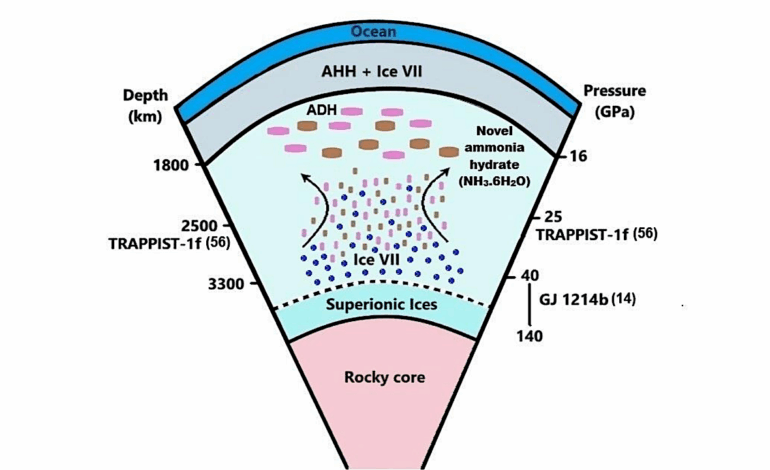New Findings Reveal Ultra-Water-Rich Ammonia Hydrates on Exoplanets

Research has unveiled significant evidence regarding the behavior of the water-ammonia system under high pressure and high temperature conditions. This discovery is crucial for understanding the internal dynamics of icy mantles found on exoplanets. The study, conducted by a team of scientists led by Anshuman Mondal, indicates that chemical reactions occur between ammonia hemihydrate (AHH) and ice VII at temperatures exceeding 750 K and pressures above 16 GPa. These reactions lead to the stabilization of water-rich ammonia hydrates, including a newly identified compound, ultra-water-rich hydrate NH3.6H2O.
The novel hydrate features a molar ratio of 1:6 of ammonia to water, coexisting with ammonia dihydrate (ADH) at a 1:2 ratio and excess ice VII. This solid phase assembly is stable at pressures up to at least 30 GPa and temperatures reaching 1600 K. Remarkably, it can also be quenched to room temperature, a finding that could reshape models of exoplanetary mantles.
Implications for Exoplanetary Research
The results suggest that water-rich ammonia hydrates are prevalent in the icy mantles of exoplanets with masses between 1-2 M Earth, irrespective of the ammonia content present during their formation and evolution, as long as sufficient excess H2O ice is available. The buoyancy contrast between these water-rich hydrates and ice VII could have significant implications for chemical stratification within these icy mantles. This stratification may influence the thermal evolution of exoplanets, presenting new avenues for research in planetary science.
The findings, detailed in a comprehensive study spanning 22 pages and accompanied by five figures, were made public on August 16, 2025. The research has been documented in the arXiv repository under the identifier arXiv:2508.11924.
The collaborative effort included contributions from scientists Katharina Mohrbach, Timofey Fedotenko, Mandy Bethkenhagen, Hanns-Peter Liermann, and Carmen Sanchez-Valle. Their work not only enhances our understanding of the physical and chemical properties of icy exoplanetary bodies but also opens up discussions regarding the nature of these distant worlds.
As research in astrobiology progresses, the implications of these findings could lead to a better understanding of the potential for life elsewhere in the universe. The study emphasizes the importance of studying complex chemical systems under extreme conditions, which may mirror the environments found on distant exoplanets.






